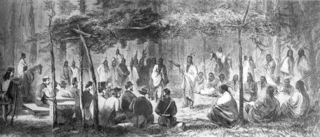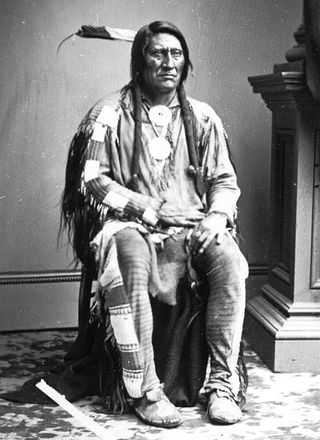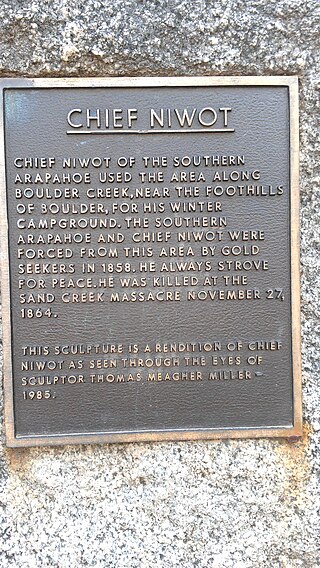
The Cheyenne are an Indigenous people of the Great Plains. Their Cheyenne language belongs to the Algonquian language family. Today, the Cheyenne people are split into two federally recognized nations: the Southern Cheyenne, who are enrolled in the Cheyenne and Arapaho Tribes in Oklahoma, and the Northern Cheyenne, who are enrolled in the Northern Cheyenne Tribe of the Northern Cheyenne Indian Reservation in Montana. The Cheyenne comprise two Native American tribes, the Só'taeo'o or Só'taétaneo'o and the Tsétsêhéstâhese. The tribes merged in the early 19th century.

The Sand Creek massacre was a massacre of Cheyenne and Arapaho people by the U.S. Army in the American Indian Wars that occurred on November 29, 1864, when a 675-man force of the Third Colorado Cavalry under the command of U.S. Volunteers Colonel John Chivington attacked and destroyed a village of Cheyenne and Arapaho people in southeastern Colorado Territory, killing and mutilating an estimated 69 to over 600 Native American people. Chivington claimed 500 to 600 warriors were killed. However, most sources estimate around 150 people were killed, about two-thirds of whom were women and children. The location has been designated the Sand Creek Massacre National Historic Site and is administered by the National Park Service. The massacre is considered part of a series of events known as the Colorado Wars.

Black Kettle was a prominent leader of the Southern Cheyenne during the American Indian Wars. Born to the Northern Só'taeo'o / Só'taétaneo'o band of the Northern Cheyenne in the Black Hills of present-day South Dakota, he later married into the Wotápio / Wutapai band of the Southern Cheyenne.

The Medicine Lodge Treaty is the overall name for three treaties signed near Medicine Lodge, Kansas, between the Federal government of the United States and southern Plains Indian tribes in October 1867, intended to bring peace to the area by relocating the Native Americans to reservations in Indian Territory and away from European-American settlement. The treaty was negotiated after investigation by the Indian Peace Commission, which in its final report in 1868 concluded that the wars had been preventable. They determined that the United States government and its representatives, including the United States Congress, had contributed to the warfare on the Great Plains by failing to fulfill their legal obligations and to treat the Native Americans with honesty.

The Dog Soldiers or Dog Men are historically one of six Cheyenne military societies. Beginning in the late 1830s, this society evolved into a separate, militaristic band that played a dominant role in Cheyenne resistance to the westward expansion of the United States in the area of present-day Kansas, Nebraska, Colorado, and Wyoming, where the Cheyenne had settled in the early nineteenth century.

The Battle of Washita River occurred on November 27, 1868, when Lt. Col. George Armstrong Custer's 7th U.S. Cavalry attacked Black Kettle's Southern Cheyenne camp on the Washita River.

The Colorado War was an Indian War fought in 1864 and 1865 between the Southern Cheyenne, Arapaho, and allied Brulé and Oglala Sioux peoples versus the U.S. Army, Colorado militia, and white settlers in Colorado Territory and adjacent regions. The Kiowa and the Comanche played a minor role in actions that occurred in the southern part of the Territory along the Arkansas River. The Cheyenne, Arapaho, and Sioux played the major role in actions that occurred north of the Arkansas River and along the South Platte River, the Great Platte River Road, and the eastern portion of the Overland Trail. The United States government and Colorado Territory authorities participated through the 1st Colorado Cavalry Regiment, often called the Colorado volunteers. The war was centered on the Colorado Eastern Plains, extending eastward into Kansas and Nebraska.

The 3rd Colorado Cavalry Regiment was a Union Army unit formed in the mid-1860s when increased traffic on the United States emigrant trails and settler encroachment resulted in numerous attacks against them by the Cheyenne and Arapaho. The Hungate massacre and the display in Denver of mutilated victims raised political pressure for the government to protect its people. Governor John Evans sought and gained authorization from the War Department in Washington to found the Third. More a militia than a military unit, the "Bloodless Third" was composed of "100-daysers," that is, volunteers who signed on for 100 days to fight against the Indians. The unit's only commander was Col. George L. Shoup, a politician from Colorado. The regiment was assigned to the District of Colorado commanded by Col. John M. Chivington.

William Wells Bent was a frontier trader and rancher in the American West, with forts in Colorado. He also acted as a mediator among the Cheyenne Nation, other Native American tribes and the expanding United States. With his brothers, Bent established a trade business along the Santa Fe Trail. In the early 1830s Bent built an adobe fort, called Bent's Fort, along the Arkansas River in present-day Colorado. Furs, horses and other goods were traded for food and other household goods by travelers along the Santa Fe trail, fur-trappers, and local Mexican and Native American people. Bent negotiated a peace among the many Plains tribes north and south of the Arkansas River, as well as between the Native American and the United States government.

Roman Nose, also known as Hook Nose, was a Native American of the Northern Cheyenne. He is considered to be one of, if not the greatest and most influential warriors during the Plains Indian War of the 1860s. Born during the prosperous days of the fur trade in the 1820s, he was called Môséškanetsénoonáhe ("Bat") as a youth. He later took the warrior name Wokini, which the whites rendered as Roman Nose. Considered invincible in combat, this fierce warrior distinguished himself in battle to such a degree that the U.S. military mistook him for the Chief of the entire Cheyenne nation.

Lean Bear, alternatively translated as Starving Bear, was a Cheyenne peace chief. He was a member of the Council of Forty-four, a tribal governance devoted to maintaining peace with encroaching United States settlers. Lean Bear's most notable peace deals include the Treaty of Fort Wise and a meeting with US President Abraham Lincoln. His work towards peace between his people and the American settlers in the Southern Plains was cut short when he was killed by the 1st Colorado Cavalry Regiment and violent retaliations ensued.
The Treaty of Fort Wise of 1861 was a treaty entered into between the United States and six chiefs of the Southern Cheyenne and four of the Southern Arapaho Indian tribes. A significant proportion of Cheyennes opposed this treaty on the grounds that only a minority of Cheyenne chiefs had signed, and without the consent or approval of the rest of the tribe. Different responses to the treaty became a source of conflict between whites and Indians, leading to the Colorado War of 1864, including the Sand Creek Massacre.
Little Rock was a council chief of the Wutapiu band of Southern Cheyennes. He was the only council chief who remained with Black Kettle following the Sand Creek massacre of 1864.
Cheyenne military societies are one of the two central institutions of traditional Cheyenne native American tribal governance, the other being the Council of Forty-four. While council chiefs are responsible for overall governance of individual bands and the tribe as a whole, the headmen of military societies are in charge of maintaining discipline within the tribe, overseeing tribal hunts and ceremonies, and providing military leadership. Historically, council chiefs selected which of the six military societies would assume these duties; after a period of time on-duty, the chiefs would select a different society to take up the duties.
Medicine Arrows (c.1795—1876) was a Cheyenne chief and Keeper of the Medicine Arrows from 1850 until his death. Rock Forehead became known to whites as Medicine Arrows after his appointment to this office. Among the Cheyenne he was also known by the nickname "Walks with His Toes Turned Out."

Chief Niwot or Left Hand(-ed) was a Southern Arapaho chief, diplomat, and interpreter who negotiated for peace between white settlers and the Cheyenne and Arapaho tribes during the Pike's Peak Gold Rush and Colorado War.

George Bent, also named Ho—my-ike in Cheyenne, was a Cheyenne-Anglo who became a Confederate soldier during the American Civil War and waged war against Americans as a Cheyenne warrior afterward. He was the mixed-race son of Owl Woman, daughter of a Cheyenne chief, and the American William Bent, founder of the trading post named Bent's Fort and a trading partnership with his brothers and Ceran St. Vrain. Bent was born near present-day La Junta, Colorado, and was reared among both his mother's people, his father and other European Americans at the fort, and other whites from the age of 10 while attending boarding school in St. Louis, Missouri. He identified as Cheyenne.
Tall Bull (Hotóa'ôxháa'êstaestse) was a chief of the Cheyenne Dog Soldiers. Of Cheyenne and Lakota parentage, like some of the other Dog Soldiers by that time, he identified as Cheyenne.
Little Owl was a Northern Arapaho chief who signed the Treaty of Fort Laramie (1851). Disturbed by the ways in which the United States government neglected to honor their promises made in the treaty, Little Owl refused to participate in discussion and signing of the Fort Wise Treaty.

White Antelope was a chief of the Southern Cheyenne. He was known for his advocacy of peace between white Americans living in the Great Plains until his killing at the Sand Creek massacre. Accounts of the massacre conflict as to whether White Antelope led his people in resistance to the attack or continued to advocate for peace until his death. White Antelope's body was desecrated after the massacre, and the blanket he was wearing stolen.